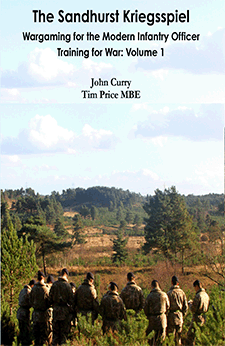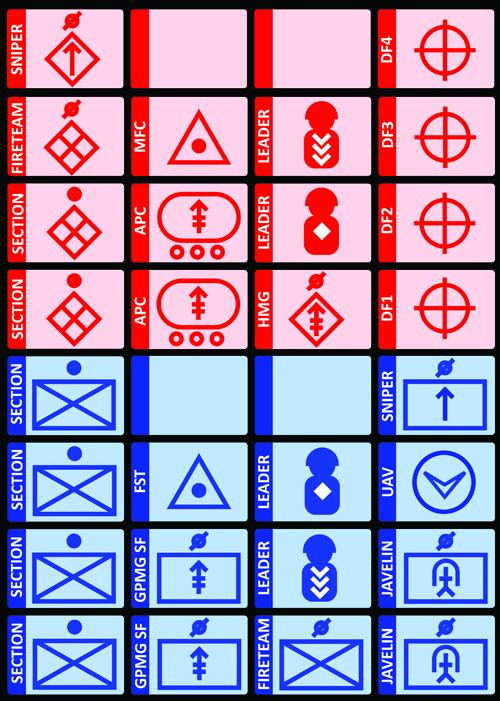The History of Wargaming Project
The project aims to make the largest possible collection of wargaming books and rules available to the modern reader. Ranging from second editions of wargaming classics, to professional wargaming rules used by the military and innovations in current wargaming.

|
|
Professional Wargaming

|
The Sandhurst Kriegsspiel, Wargaming for the
Modern Infantry Officer |
|---|---|
|
"This is not a game; this is training for war. I must recommend it to
the whole Army!"
Baron von Muffling, Chief of the Prussian General Staff, commenting on
the 1824 von Reisswitz Kriegsspiel wargame rules.
This book contains 4 ready to use wargames:
Game 1: The Sandhurst Kriegsspiel aims to allow officers to test the
plan they devised in a TEWT on the actual ground using the tool of
wargaming. The explanation includes an example of a platoon as well as a
company level game.
Game 2: The Battlegroup Kriegsspiel is next level up game. While still a
kriegsspiel, dependent on sound military judgement by the umpire (and
players), it includes some hard operational research based tables to
help arbitrate the combat outcomes.
Game 3: Current Ops: the Modern Infantry Battle is a more rigid
kriegsspiel, with more detailed rules to govern movement, combat,
suppression and ammunition expenditure. It is more similar in format to
the hobby wargames, but still embeds some key military lessons within
it.
Game 4: Counter IED Kriegsspiel is an excellent example of using some of
the recent developments in wargaming to create an engaging game to be
used as part of training around patrolling when faced by an IED threat.
The Sandhurst Kriegsspiel is published by the History of Wargaming
Project, as part of the series documenting current practice in
professional wargaming.
|
|
|
|
Supporting Maps and Counters for
these Games
|
||||||||
Review of The Sandhurst Kriegsspiel by Rex BrynanFirst published on the Pax Sims Blog on 16/12/16 and is reproduced with permissionRecent years have seen an effort to (re)introduce a greater quantity and quality of wargaming into professional military education, notably in the United States and United Kingdom. This volume contains a number of British examples. It is written by two well-known experts in the field, John Curry (of the History of Wargaming Project) and the prolific but ever-elusive “Tim Price” (a currently-serving British military officer). Another British officer, Ed Farren, has also contributed to the collection. The book is amply illustrated with maps and pictures, and additional materials are available for download at the History of Wargaming Project website. The book contains four wargames. The first, the Sandhurst Kriegsspiel, is a platoon- or company-level action meant to be played following a TEWT (tactical exercise without troops) earlier in the day. During the TEWT, officer cadets physically visit the nearby “battlefield” and ascertain how they might defend or assault a designated position. During the kriegsspiel, they then play this out against each other on a map using simple wargaming rules. The authors note one absolutely key point that underscores the value of wargames as an educational, training, and planning tool, namely what a fundamental difference it can make when one introduces an intelligent and adaptive adversary into the process:
The second game included in the collection is the Battlegroup Kriegsspiel, which introduces a simple map-based wargame involving multiple platoons and companies. The Modern Infantry Battle (or “Future UK Army Concepts”) wargame was developed to explore the implications of possible reorganization and reductions in the size of British infantry companies. This is somewhat more dependent on formal rules, and less dependent on umpire adjudication. Finally, Ed Farren’s Counter-IED Kriegsspiel has students play the role of a Blue force attempting to complete an assigned task—and a Red force placing IEDs and ambushes to try to prevent this and inflict casualties. All of these games are quite simple, but in many ways that is the point: even relatively quick and simple wargames can provide insight into military operations in a way that explores their inherently adversarial nature. The many appendices to the volume include a summary of the UK military decision-making (or combat estimative) process; a (rather critical) British military assessment of the SPI commercial wargame Firefight (1977), notes on British Army weapons, and sample unit counters for the games. The primary targets of this book are those engaged in tactical and operational military training. However those interested in teaching military operations in other contexts (including in university courses on modern warfare, which are often peculiarly devoid of any exploration of the tactical, operational, and strategic arts) will also find it useful. Hobby gamers may also derive from enjoyment in trying out the rules and scenarios with their opponents, in a “can you beat a Sandhurst officer cadet” sort of way. |
